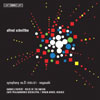Schnittke Symphony No 0; Nagasaki
Early Schnittke proves intriguing
View record and artist detailsRecord and Artist Details
Composer or Director: Alfred Schnittke
Genre:
Orchestral
Label: BIS
Magazine Review Date: 13/2007
Media Format: CD or Download
Media Runtime: 0
Mastering:
Stereo
Catalogue Number: BISCD1647

Tracks:
| Composition | Artist Credit |
|---|---|
| Symphony No 0 |
Alfred Schnittke, Composer
Alfred Schnittke, Composer Cape Town Symphony Orchestra Owain Arwel Hughes, Conductor |
Author: Philip_Clark
As Symphony No 0s go, Alfred Schnittke’s student piece really isn’t bad. A substantial four-movement work that’s not short on meaty thematic material and flashes of original orchestration, it was premiered in 1957 by the Moscow Conservatory Symphony Orchestra conducted by Algis Zhiuratis. Present in the house were Shostakovich and Kabalevsky – the former presumably smiling at the flattery of imitation.
This isn’t the direct descent of a First Symphony like Bruckner’s Symphony No 0. The road to the polystylistic montage of Schnittke’s First Symphony was a long one, but something special is brewing here among the over-learnt academic padding. Embedded within the Shostakovich-like harmonies in the opening of the first movement, I’m hearing Tchaikovsky in the broody low-register clarinet theme. The movement begins ambiguously, as if we’re abruptly joining a piece that’s already been playing for 20 minutes. In the third movement there’s a striking near-Ivesian moment as an orchestral tutti suddenly breaks to reveal an underlying stratum of strings. This is music “composed of” as much as “composed”. The contrivances of Schnittke’s finale, with its vanilla fanfares and desperate tying together of loose ends, tell of impending deadlines. But no Schnittke fan could help but be intrigued by this early symphonic essay.
Written a year later, his oratorio Nagasaki was a bold attempt at personal expression that, inevitably, landed him in bother with the authorities. It contains some passionately sincere vocal writing, even if the Hammer Horror sounds deployed to depict the atomic bomb dropping suggest a degree of compositional naivety.
This isn’t the direct descent of a First Symphony like Bruckner’s Symphony No 0. The road to the polystylistic montage of Schnittke’s First Symphony was a long one, but something special is brewing here among the over-learnt academic padding. Embedded within the Shostakovich-like harmonies in the opening of the first movement, I’m hearing Tchaikovsky in the broody low-register clarinet theme. The movement begins ambiguously, as if we’re abruptly joining a piece that’s already been playing for 20 minutes. In the third movement there’s a striking near-Ivesian moment as an orchestral tutti suddenly breaks to reveal an underlying stratum of strings. This is music “composed of” as much as “composed”. The contrivances of Schnittke’s finale, with its vanilla fanfares and desperate tying together of loose ends, tell of impending deadlines. But no Schnittke fan could help but be intrigued by this early symphonic essay.
Written a year later, his oratorio Nagasaki was a bold attempt at personal expression that, inevitably, landed him in bother with the authorities. It contains some passionately sincere vocal writing, even if the Hammer Horror sounds deployed to depict the atomic bomb dropping suggest a degree of compositional naivety.
Discover the world's largest classical music catalogue with Presto Music.

Gramophone Digital Club
- Digital Edition
- Digital Archive
- Reviews Database
- Full website access
From £8.75 / month
Subscribe
Gramophone Full Club
- Print Edition
- Digital Edition
- Digital Archive
- Reviews Database
- Full website access
From £11.00 / month
Subscribe
If you are a library, university or other organisation that would be interested in an institutional subscription to Gramophone please click here for further information.




